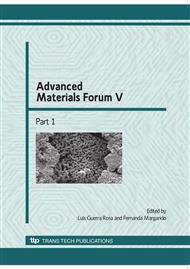p.111
p.119
p.124
p.130
p.136
p.142
p.149
p.155
p.161
Structural Characterisation and Mechanical Stability of Titanium Substituted Mesoporous Materials
Abstract:
Mesoporous silica and titanium SBA-15 samples with different Si/Ti molar ratio were prepared by direct one-step synthesis under strongly acidic hydrothermal conditions. The materials were characterised by X-ray diffraction, nitrogen adsorption at 77K. The Si/Ti values of the final calcined materials were determined by ICP analysis. It was found that all samples presented 2-D hexagonal structures with high degree of ordering. However, the metal content incorporated in all titanium mesoporous materials was very low, i.e., the Si/Ti molar ratio values of the final calcined samples are significantly different from the initial Si/Ti molar ratio in the synthesis gel. A study of mechanical stability in air was performed by exposing the calcined samples to a unidirectional external pressure in the range 74-814MPa. X-ray diffraction and nitrogen adsorption at 77K, on selected compacted samples, were used in order to evaluate the changes in mesoporous structure. It was found that, for all freshly calcined pure silica and titanium containing samples tested, the high quality SBA-15 structure is still observed after the application 148-370MPa of a unidirectional external pressure and the collapse of the pore structure occurs at around 814MPa.
Info:
Periodical:
Pages:
136-141
Citation:
Online since:
January 2010
Price:
Сopyright:
© 2010 Trans Tech Publications Ltd. All Rights Reserved
Share:
Citation:


